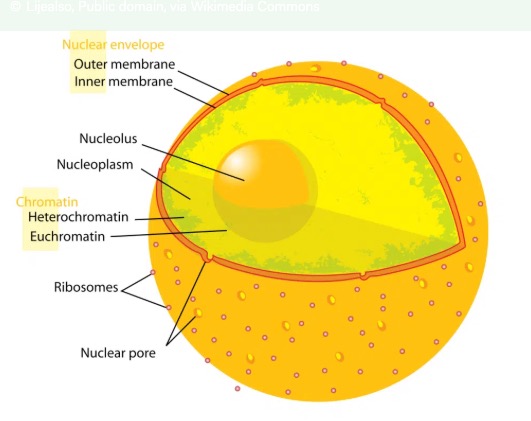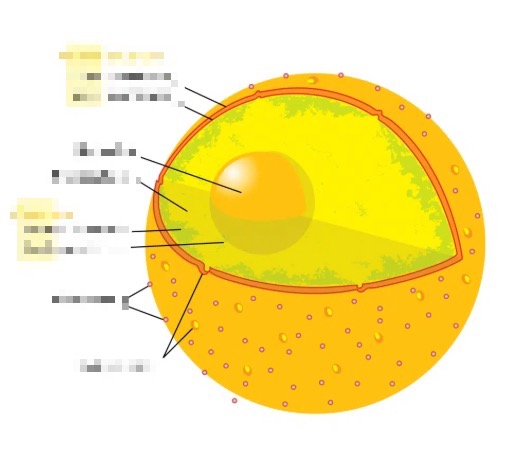A Closer Look at Cells: Plant vs. Animal
A Closer Look at Cells: Plant vs. Animal
At the end of this lesson, you are expected to:
Identify the nucleus and its location within a cell.
Explain the function of the nucleus as the control center of the cell.
Describe the role of DNA and chromosomes within the nucleus.
Understand how the nucleus directs the cell's activities.
Imagine your school is like a cell. Who do you think is in charge of making sure everything runs smoothly, like classes start on time, students learn new things, and everyone follows the rules? It's probably the principal or the school administration, right? They have all the important information and give instructions to keep the school organized and working well.
Now, think about a cell. It's a tiny, busy place with lots of different jobs happening all at once. Just like a school needs a leader, a cell also has a special part that acts like its "brain" or "control center." What do you think this part might be called? Let's find out in our lesson today!
Welcome, young scientists! Today, we're going to explore a very important part of the cell, a part that's like the captain of a ship, the director of a play, or the principal of our school. This special part is called the nucleus.
What is the Nucleus?
The nucleus is a membrane-bound organelle found in eukaryotic cells. Eukaryotic cells are the more complex types of cells that make up plants, animals, fungi, and protists. Prokaryotic cells, like bacteria, do not have a nucleus.
Think of the nucleus as a command center or a control room for the cell. It's usually located near the center of the cell, but its exact position can vary depending on the type of cell. It's like the main office in our school where all the important decisions are made.
What Does the Nucleus Look Like?
The nucleus is typically spherical or oval-shaped. It is enclosed by a special covering called the nuclear envelope, which is like a protective wall around the control center. This envelope has tiny pores, like little doors, that allow certain substances to pass in and out of the nucleus, controlling what goes in and out of the control room.
 Inside the nucleus, we find a jelly-like substance called nucleoplasm. Within the nucleoplasm are two very important things:
Inside the nucleus, we find a jelly-like substance called nucleoplasm. Within the nucleoplasm are two very important things:
Chromosomes: These are like the instruction manuals or blueprints of the cell. They are made of a substance called DNA (Deoxyribonucleic Acid). DNA carries all the genetic information that determines our traits – like eye color, hair color, and even how tall we grow. When a cell is not dividing, the DNA is spread out in a tangled form called chromatin. But when the cell is about to divide, the chromatin coils up tightly to form visible structures called chromosomes. Humans have 23 pairs of chromosomes in most of their cells!
Nucleolus: This is a smaller, dense structure found inside the nucleus. The nucleolus is like the factory within the control center that makes ribosomes. Ribosomes are tiny structures that are essential for building proteins, which are the building blocks of our bodies and carry out many important functions.
Why is the Nucleus Called the "Control Center"?
The nucleus is called the control center because it holds the cell's genetic material (DNA) and controls all the cell's activities. Here’s how it does that:
Storing Genetic Information: The DNA inside the nucleus contains the instructions for everything the cell needs to do. It tells the cell what proteins to make, when to grow, when to divide, and when to perform its specific job.
Controlling Growth and Reproduction: The nucleus directs when a cell should grow and when it should divide to make new cells. This is crucial for growth, repair, and reproduction. For example, when you get a cut, the nucleus in the surrounding cells directs them to divide and make new skin cells to heal the wound.
Regulating Gene Expression: Not all instructions in the DNA are needed all the time. The nucleus controls which genes (sections of DNA) are "turned on" or "turned off" at any given time. This ensures that the cell only makes the proteins it needs, when it needs them, and in the right amounts. Think of it like a light switch – you only turn on the lights when you need them!
Making Ribosomes: As we mentioned, the nucleolus inside the nucleus makes ribosomes. Ribosomes then move out of the nucleus into the cytoplasm, where they build proteins according to the instructions sent from the DNA.
The Nucleus and DNA: The Cell's Master Plan
DNA is truly amazing! It's like a long, twisted ladder, and the rungs of the ladder are made of different chemical "letters" (A, T, C, and G). The specific order of these letters forms the genetic code. This code is read by the cell to build proteins.
Imagine you have a recipe book (the DNA) in the nucleus. This recipe book contains instructions for making all sorts of things the cell needs, like enzymes to digest food or proteins to build muscles. When the cell needs to make something, a copy of the relevant recipe (a gene) is made. This copy, called messenger RNA (mRNA), then travels out of the nucleus to the ribosomes in the cytoplasm, where it's used to assemble the protein.
Real-World Examples:
The Principal's Office: Think about your school principal. They have the school's master plan, schedules, and important rules. They give instructions to teachers and staff to ensure everything runs smoothly. The nucleus is like the principal's office for the cell, holding the DNA (master plan) and directing all the cell's activities.
A Computer's CPU: In a computer, the Central Processing Unit (CPU) is the "brain" that processes information and controls all the operations. The nucleus acts similarly for the cell, processing the genetic information and controlling the cell's functions.
A Recipe Book: Imagine you want to bake a cake. You go to your recipe book (DNA in the nucleus) to find the instructions. You might write down the recipe on a separate piece of paper (mRNA) to take to the kitchen (cytoplasm) where you mix the ingredients (amino acids) to make the cake (protein).
The Nucleus in Plant vs. Animal Cells:
Both plant and animal cells have a nucleus. However, there can be slight differences in their appearance or location. In most animal cells, the nucleus is a prominent, central organelle. In plant cells, the large central vacuole can sometimes push the nucleus to the side. But in both, its function as the control center remains the same.
Why is Understanding the Nucleus Important?
Understanding the nucleus is fundamental to understanding how cells work, how organisms grow, and how traits are passed down from parents to offspring. Many diseases, including cancer, involve problems with how cells divide and how the nucleus controls these processes. By studying the nucleus, scientists can learn more about life itself and find ways to treat diseases.
Guided Practice: Label the Nucleus!
Let's practice identifying the nucleus and its parts. Look at the diagram below. Can you label the nucleus and its main components?

Word Bank: Nucleus, Nuclear Envelope, Chromosomes, Nucleolus, Nucleoplasm
Instructions: Write the correct label from the word bank next to each letter in the diagram.
Interactive Activity: "DNA Says" Game
This game is like "Simon Says," but with a twist!
Instructions:
Imagine you are the nucleus. Your DNA has given you instructions.
When I say "DNA says, [do an action]," you should do that action. For example, "DNA says, make ribosomes!" (You could pretend to build something).
If I say "[do an action]" without saying "DNA says," you should NOT do it. If you do, you're out!
Let's try some instructions:
"DNA says, grow bigger!" (Stretch your arms out)
"DNA says, make proteins!" (Pretend to assemble something)
"DNA says, divide!" (Pretend to split into two)
"Make proteins!" (Do nothing!)
"DNA says, send a message!" (Pretend to write a message)
This game helps you understand how the nucleus directs the cell's actions based on the instructions from DNA.
Independent Practice: Nucleus Fact File
Create a "Fact File" about the nucleus. You can draw it in your notebook or use a computer if available. Include the following:
A drawing: Draw a plant cell and an animal cell, clearly labeling the nucleus in each.
Key Features: List the main parts of the nucleus (nuclear envelope, nucleoplasm, chromosomes/chromatin, nucleolus).
Main Job: Write a short sentence explaining the nucleus's main job as the control center.
Analogy: Think of your own analogy for the nucleus (like the principal's office or CPU) and explain why it fits.
Think about how important rules and instructions are in our daily lives. Without them, things would be chaotic! The nucleus is essential for the survival and proper functioning of every eukaryotic cell.
Growth and Development: From the moment you were conceived, your cells have been dividing and growing, following the instructions in the nucleus. This allows you to develop from a tiny baby into the person you are today.
Healing: When you scrape your knee, the cells around the wound need to know how to repair the damage. The nucleus directs these cells to divide and create new skin, healing the injury.
Heredity: The DNA in the nucleus is passed down from your parents. This is why you might have your mother's eyes or your father's smile. The nucleus ensures that this genetic information is accurately copied and passed on to new cells and, eventually, to future generations.
The nucleus is a membrane-bound organelle found in eukaryotic cells.
It is often called the "control center" or "brain" of the cell.
The nucleus contains the cell's genetic material, DNA, organized into chromosomes.
The nucleus controls the cell's growth, reproduction, and all its activities by regulating gene expression.
The nucleolus, found inside the nucleus, is responsible for making ribosomes.
The nuclear envelope protects the nucleus and controls what enters and leaves.
Now that you know about the nucleus, let's apply this knowledge!
Observe and Compare: If you have access to a microscope and prepared slides of plant and animal cells (like onion skin and cheek cells), try to locate the nucleus in each. Note any differences you observe in its appearance or position.
Create a Cell Model: Make a simple model of a cell (using clay, paper, or drawings) and clearly label the nucleus and its main parts. Explain its function to a family member or friend.
Research a Disease: Choose a disease that affects cell division or genetic information (like cancer or genetic disorders) and do a simple research project on how the nucleus is involved. You can look for information online or in books. Remember to ask for help from an adult if you need it!
No Comments Yet